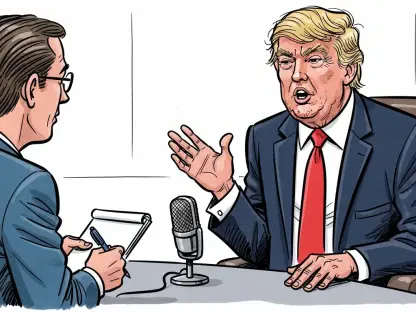The imposition of U.S. tariffs has sparked a wave of economic recalibrations across the globe, with far-reaching effects that transcend national borders. At the heart of these developments is the revised economic outlook presented by the International Monetary Fund (IMF), which has cast a spotlight on the transformative impact of these protectionist measures. Targeting Canada—a significant trade partner—and other international players, the tariffs have set off a chain reaction affecting Gross Domestic Product (GDP) projections and altering trade dynamics. As the world tilts towards more protectionist policies, the nuances of these changes offer critical insights into the future paths of national economies and global economic growth. The ensuing discussion revolves around key areas affected by these changes, including specific country impacts, inflationary trends, and broader international trade ramifications.
Canada and the U.S. in the Trade Crossfire
The Canadian economy, closely linked to that of the U.S., finds itself in a precarious position amid escalated trade tensions. The introduction of tariffs on Canadian exports—specifically a 25% tariff on non-energy goods and a 10% tariff on energy goods—has resulted in notable economic repercussions. Canada’s growth forecasts, once more optimistic, have been dialed back significantly by the IMF. The projected GDP growth now stands at lower figures than previously anticipated, reflecting the direct impacts of these tariffs on the national economy. Additionally, Canada’s retaliatory tariffs on U.S. goods illuminate the growing complexity of North American trade relations, resulting in diminished bilateral trade flows. The Canada-United States-Mexico Agreement presents a partial shield against certain tariff impacts, but it cannot wholly mitigate the broader economic strain, emphasizing the changing landscape of economic ties between these nations.
Moreover, the economic narrative of North America is fraught with challenges that underscore the inherent volatility in current U.S. economic policies. This unpredictability extends beyond immediate economic figures and delves into the nuanced trade relationships that have historically underpinned North American economic growth. Canada’s strategic responses to these tariffs, including targeted retaliations, highlight a dynamic interplay of economic forces that reshapes traditional trade alignments. As Canada navigates these turbulent waters, the ramifications extend beyond its borders, implicating wider geopolitical and economic considerations. This evolving discourse points to a future where traditional economic partnerships may need to be reinvented to sustain growth and stability within the region.
Global Economic Implications
On a global scale, the influence of U.S. tariffs is mirrored through shifting economic forecasts that convey a climate of uncertainty and transformation. The IMF’s revised global growth projections depict a notable downshift in expected economic expansion, reflecting the pervasive reach of these protectionist measures. International growth forecasts have been trimmed, aligning with a broader narrative that paints an increasingly unpredictable economic environment. These revisions place greater emphasis on the fluidity of modern economic projections, demonstrating the rapidity with which policy shifts in one nation can reverberate across the globe. Such a scenario challenges the customary predictors of global economic health, necessitating adaptive strategies to counteract potential adverse outcomes.
The adjustments to global growth projections reveal the intrinsic interconnectedness of economies worldwide. The repercussions of tariff impositions extend well beyond any single nation, affecting international trade and investment flows in a manner that demands strategic recalibrations. Traditional economic models, which once relied on consistent policy environments and stable trade routes, are now being reevaluated in light of emerging uncertainties. These forecasts are not merely abstract figures; they encapsulate real-world impacts on industries, consumer confidence, and broader economic sentiment. As policymakers, businesses, and international organizations grapple with these challenges, the need for cooperative solutions that emphasize agility, foresight, and resilience becomes increasingly apparent.
Inflationary Pressures and Central Bank Vigilance
Inflationary escalation emerges as a pivotal consequence of U.S.-imposed tariffs, impacting advanced economies by driving up prices and altering economic forecasts. These tariffs have contributed to heightened inflation rates, prompting both concern and action among global policymakers. As global inflation rates climb, the Federal Reserve and other central banks are urged to maintain vigilant monetary policies to mitigate potential economic disruptions. Forecasts now indicate inflation reaching significant levels, necessitating proactive measures to stabilize economies. The link between U.S. tariffs and rising inflation underscores the intricate web of factors influencing economic stability and growth, spotlighting the role of monetary policy in navigating these complexities.
Central banks face a delicate balancing act amid rising inflationary pressures. The need to safeguard economic growth while curbing inflation calls for nuanced and decisive policy maneuvers. In an environment shaped by trade policy shifts, the traditional levers of economic stabilization—such as interest rates and regulatory frameworks—demand careful reconsideration. The evolving inflationary landscape revives debates around central bank independence as policymakers weigh the merits of maintaining strict inflation targets against the realities of economic growth imperatives. This dynamic highlights the complex interplay between external economic forces and internal policy decisions, where the synchronization of strategies can be pivotal in ensuring long-term economic resilience.
Wider Economic Concerns
The economic repercussions of U.S. tariffs resonate throughout the global landscape, eliciting varied responses from different nations. In Mexico, for example, the country faces economic contraction—a direct outcome of its interconnected trade relationship with the U.S. The IMF’s forecast reflects a downturn, with the possibility of recovery hinging on strategic measures and renewed economic alignment. This contraction illustrates the wider vulnerabilities in economies entwined with the U.S. and highlights the cascading impact of trade barriers on emerging markets. Globally, the reduced expectations for countries like China and those in Europe represent the tangible challenges that nations face in sustaining growth amid shifting trade dynamics.
These economic adjustments underscore a larger theme of recalibration within the global trade ecosystem. The interplay between U.S. tariffs and economic performance highlights the urgency for comprehensive strategies to weather the storms of protectionism. As the global trade growth rate dwindles—partially due to diminished U.S.-China trade—countries must explore new avenues for economic revitalization. This includes leveraging regional trade agreements, fostering innovation, and diversifying economic partners to offset the impact of tariffs. As nations navigate this complex terrain, decision-makers are called upon to foster environments that support resilience, adaptability, and inclusivity as pillars of sustained economic vitality.
Achieving Trade Balance and Cooperation
The Canadian economy, deeply tied to the U.S., stands on shaky ground due to escalating trade tensions. The U.S. imposed a 25% tariff on non-energy Canadian exports and a 10% tariff on energy goods, triggering significant economic effects. Once upbeat growth forecasts by the IMF have been sharply reduced, with Canada’s GDP growth rates falling short of prior expectations, underscoring the tariff’s repercussions on its economy. In response, Canada’s retaliatory tariffs on U.S. products add a layer of complexity to North American trade relations, resulting in decreased trade flows between the two nations. The Canada-United States-Mexico Agreement offers some protection against certain tariff impacts, but it cannot fully alleviate the broader economic challenges. These tariffs, and the consequences they bring, highlight the fluidity and uncertainty in current U.S. economic policies, demanding strategic responses from Canada. As such, traditional trade relationships may need to be redefined for sustained stability and growth across North America, emphasizing geopolitical factors.









